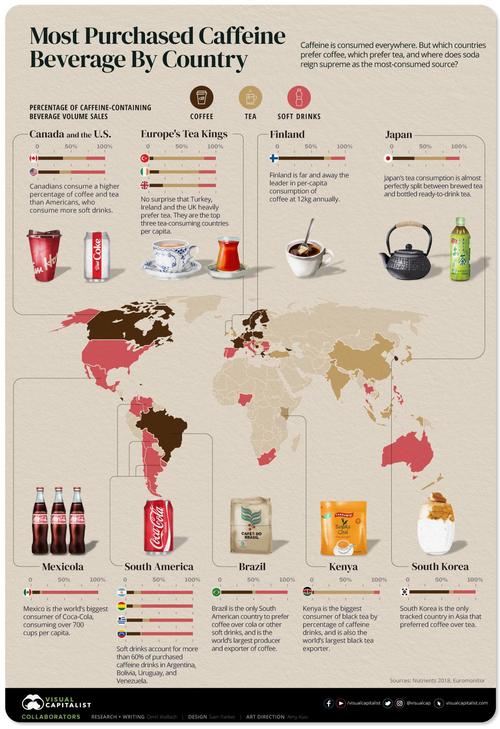Coffee, Tea, Or Soda: What Caffeine Drinks Do Countries Prefer?
Coffee, tea, or soft drinks… How do you get your caffeine fix?
It might be the world’s most widely consumed psychoactive substance, but your preferred caffeine drink of choice might come down to where you live.
As Visual Capitalist's Omri Wallach details below, a study into caffeine consumption of 57 countries examined the role it plays in our diets, using the volume sales of caffeine-containing beverages from Euromonitor to see what caffeine source each country prefers.
The resulting map of caffeine preference shows regional trends, including some surprising standouts.
Most Purchased Caffeine Drink By Country
There are many different caffeine drinks for consumers to choose from, from brewed drinks to ready-to-drink vending machine options.
To simplify tastes, we grouped them into three types:
-
Coffee — Includes fresh brewed coffee, instant coffee, and ready-to-drink coffee.
-
Tea — Includes herbal, black, green, and other teas, as well as ready-to-drink tea.
-
Soft Drinks — Includes colas, other soft drinks, sports drinks, and energy drinks.
Examining the regional spread shows us some expected caffeine strongholds.
Tea was the preferred drink of choice for many countries in most of Asia, including China, India, Indonesia, and Japan. But it also showed a strong foothold in Africa, as Kenya is the world’s largest black tea exporter, and in Europe, as Turkey, Ireland, and the UK are the world’s top three tea-consuming countries per capita.
Coffee was the most preferred caffeine drink in a number of countries in Europe, including all of the Nordic countries. It is also the drink of choice in Canada, South Korea, and Brazil, the latter two being the only countries in Asia and South America to prefer coffee.
Perhaps most surprising is the global preference for soft drinks. The U.S. and most of Latin America overwhelmingly consumed soft drinks over other caffeine drinks, as did the Philippines, Thailand, and Australia. Even in Europe, some countries that are heavy coffee drinkers like Italy and Switzerland purchased more soft drinks than coffee by narrow margins.
Coke’s Influence on the Coffee vs Tea vs Soft Drinks Debate
Though the global map of caffeine preference looks regionally-specific at a glance, there are some notable business influences at play.
The proliferation of soft drinks in Latin America is largely due to the power of Coca-Cola. Mexico, the country which preferred soft drinks the most over other drinks, is also the world’s biggest consumer of Coca-Cola per capita. Coca-Cola also reached far beyond the borders of the U.S. where it originated, becoming a staple drink in many parts of Europe, Australia, and Asia.
This power of brands extends to coffee as well. Many coffee-preferring countries actually leaned more towards instant coffee purchases over freshly brewed coffee, a mark of the lasting influence of Nestlé’s brand of instant coffee, Nescafé.
But it’s important to note that many countries were not tabulated, and that caffeine purchases don’t differentiate between every single possible caffeine drink. There are many different types of coffees, teas, soft drinks, and even yerba mate for consumers to choose from.
As a snapshot of global caffeine consumption, it’s a reminder that the world’s most commonly consumed psychoactive stimulant is taken in many different forms. Both throughout history, and in modern times.
https://ift.tt/3ilMZyX
from ZeroHedge News https://ift.tt/3ilMZyX
via IFTTT


0 comments
Post a Comment